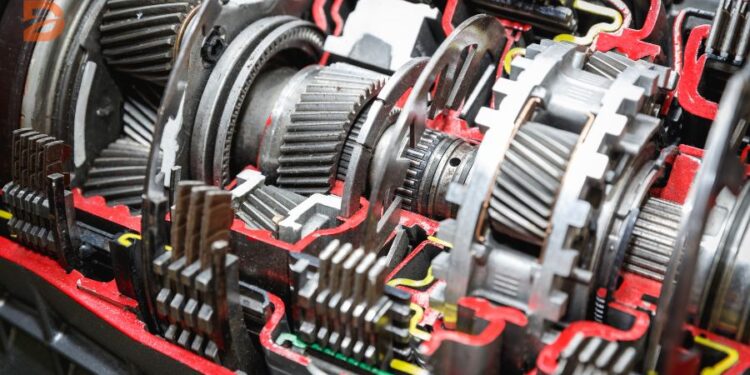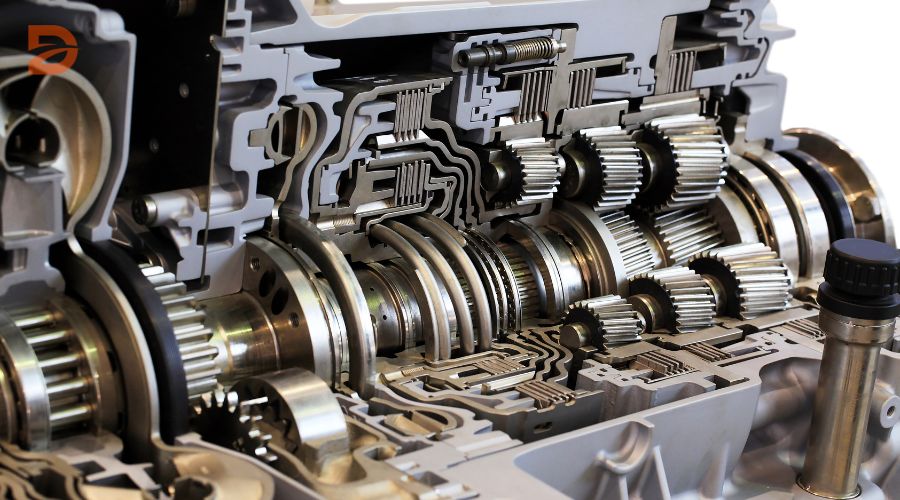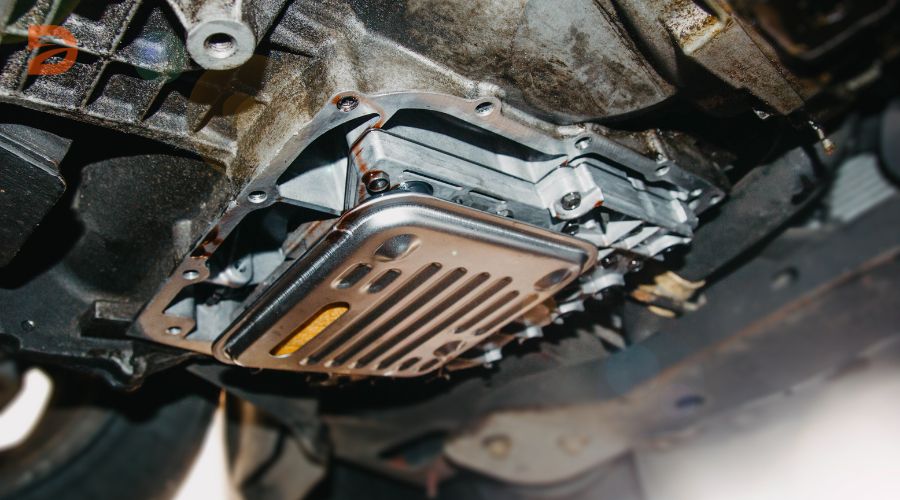Experiencing issues with your vehicle’s transmission can be a frustrating and concerning experience. When your transmission is functioning properly, it’s often overlooked, but when problems arise, it suddenly becomes the center of attention. This article will provide an overview of the common types of transmissions, the telltale signs of transmission problems, the most common transmission issues, and steps you can take to diagnose and address these problems with the help of a professional.
Have you ever wondered what’s causing those strange noises or why your car is struggling to shift gears? Unraveling the mysteries of your vehicle’s transmission might be the key to unlocking the solution. So, what is the first step in tackling transmission troubles?
Key Takeaways
- Transmissions come in three main types: manual, automatic, and CVT.
- Common signs of transmission problems include fluid leaks, rough shifting, and unusual noises.
- The most frequent transmission issues involve worn-out components like seals, clutches, and filters.
- Proper maintenance is crucial to prevent costly transmission repairs.
- Seeking professional help is often necessary for diagnosing and addressing complex transmission problems.
Understanding Transmissions: Types and Functions
Vehicles are equipped with one of three main types of transmissions: manual, automatic, and continuously variable (CVT). Each type serves a distinct purpose, offering unique features and benefits to drivers.
Manual Transmissions
Manual transmissions utilize a clutch and a manual gearbox with a stick shift that the driver operates. This transmission type provides the driver with greater control over the vehicle’s power delivery, allowing for optimal gear selection based on driving conditions. Manual transmissions are often favored by driving enthusiasts for their engaging and responsive driving experience.
Automatic Transmissions
Automatic transmissions allow the driver to select between park, reverse, and drive, with the transmission shifting gears automatically. This transmission type is designed for convenience, offering a smooth and seamless driving experience. Automatic transmissions are popular among commuters and those seeking a more relaxed driving experience.
CVT Transmissions
Continuously Variable Transmissions (CVT) use pulleys instead of gears to provide seamless power delivery. By adjusting the pulley sizes, CVTs can offer an infinite range of gear ratios, resulting in improved fuel efficiency and a more responsive acceleration feel. CVTs are commonly found in small- to mid-sized vehicles, as well as in hybrid and electric cars.
Regardless of the type, the transmission’s primary function is to transfer the engine’s power to the vehicle’s wheels, enabling smooth and efficient acceleration and deceleration. Proper maintenance and timely repairs are crucial to ensure the longevity and optimal performance of any transmission system.
| Transmission Type | Key Features | Advantages | Disadvantages |
|---|---|---|---|
| Manual |
|
|
|
| Automatic |
|
|
|
| CVT |
|
|
|
Common Signs of Transmission Problems
Your vehicle’s transmission is a complex system that plays a crucial role in its performance and operation. When transmission issues arise, it’s important to address them promptly to prevent further damage and costly repairs. Here are some common signs that may indicate a problem with your transmission:
Fluid Leaks
One of the most obvious signs of a transmission problem is a fluid leak. Look for reddish or brownish-red spots or pools on your driveway, which could indicate a transmission fluid leak. Transmission fluid leaks can lead to low fluid levels and increase the risk of overheating, further exacerbating the issue.
Strange Noises
Unusual noises coming from your transmission, such as clunking, grinding, whirring, or humming, can be a concerning sign. These sounds may indicate worn-out components or other internal problems within the transmission.
Rough Shifting or Slipping Gears
If your transmission is shifting roughly or slipping out of gear, leading to a sensation of the engine revving up and down without a corresponding change in vehicle speed, it’s likely time to have the transmission inspected. Rough gear shifting or slipping gears can be a dangerous safety issue and should be addressed promptly.
| Symptom | Possible Cause | Recommended Action |
|---|---|---|
| Transmission fluid leaks | Worn seals or gaskets, damaged transmission case | Inspect and repair leaks, top up fluid levels |
| Strange transmission noises | Worn bearings, gears, or other internal components | Have the transmission inspected and repaired by a professional |
| Rough gear shifting or slipping | Worn clutch, faulty solenoids, or transmission fluid issues | Diagnose and address the underlying cause to restore smooth shifting |
If you notice any of these signs, it’s important to have your vehicle’s transmission inspected by a professional. Addressing transmission problems early can save you significant time and money in the long run.
Transmission repair, car transmission
When it comes to transmission issues, it’s crucial to seek professional assistance. Attempting to fix transmission problems without the proper tools, parts, and expertise can lead to further damage and escalate repair costs. Transmissions are highly complex mechanical systems, and their components require meticulous assessment and specialized handling.
Automatic transmissions typically feature four to five forward gear ratios and are more complex, requiring careful diagnosis and repair by experienced auto mechanics. For manual transmission vehicles, it’s recommended to change the transmission fluid every 30,000 to 60,000 miles to maintain optimal performance.
Most modern automatic transmissions can last anywhere from 100,000 to 200,000 miles with proper maintenance, while manual transmissions typically endure longer, often exceeding 250,000 miles. This is because manual transmissions require less frequent servicing and are less picky about specific oil types.
| Repair Type | Average Cost |
|---|---|
| Transmission Repair | $800 |
| Transmission Rebuild | $3,000 |
| Transmission Replacement | $6,500 |
The course of action for transmission issues depends on the severity of the problem. A transmission repair is advisable when simple fixes are needed, and minimal damage has occurred. A transmission rebuild may be a suitable solution if multiple repairs are necessary, and the cost to rebuild the transmission is lower than the cost to replace it. Ultimately, a transmission replacement may be necessary when the transmission is damaged beyond repair and multiple repairs are needed.
Factors that can affect the cost of transmission repair, rebuild, or replacement include whether it’s an automatic or manual transmission, the age of the transmission parts, the extent of the damage, and the type of vehicle. Entrusting your car’s transmission to a reputable mechanic or transmission specialist is crucial to ensure the job is done right and to avoid further complications down the line.
Most Common Transmission Issues
Transmissions are the heart of any vehicle’s drivetrain, transferring power from the engine to the wheels. However, they can be susceptible to a variety of problems that require prompt attention. Among the most common transmission issues are leaking seals, worn-out clutches, and clogged filters.
Leaking Seals
Transmission fluid leaks can be a significant issue, leading to a loss of essential lubricant and potentially causing internal component failure. Seal deterioration or damage is a common culprit, allowing fluid to escape and causing a messy and potentially dangerous situation. Addressing leaks quickly is crucial to prevent further damage and ensure proper transmission function.
Worn-Out Clutch
In manual transmissions, the clutch is responsible for seamlessly transferring power from the engine to the drivetrain. Over time, the clutch can become worn, leading to slipping or difficulty engaging gears. This not only compromises the vehicle’s performance but can also put additional strain on other transmission components, potentially leading to more extensive and costly repairs.
Clogged Filters
Transmission filters play a vital role in keeping the fluid clean and free of contaminants, which can impede the proper flow of fluid and cause the transmission to malfunction. Neglecting regular transmission filter changes can result in a clogged filter, restricting fluid circulation and causing a range of issues, from rough shifting to complete transmission failure.
| Transmission Issue | Potential Symptoms | Consequences |
|---|---|---|
| Leaking Seals |
|
|
| Worn-Out Clutch |
|
|
| Clogged Filters |
|
|
Addressing these common transmission issues promptly can prevent further damage and costly repairs. Regular maintenance, including fluid changes and filter replacements, can help extend the life of your vehicle’s transmission and ensure smooth, reliable performance on the road.
Diagnosis and Professional Repair
When it comes to transmission issues, proper diagnosis, and professional repair are essential. Transmission problems can stem from complex underlying causes, and attempting to fix them without the proper expertise can lead to further damage and more costly repairs down the line. That’s why it’s crucial to seek the services of a skilled mechanic or transmission specialist.
Transmission specialists utilize specialized tools and equipment to accurately diagnose the issue. They may employ computerized diagnostic tools to read trouble codes, conduct road tests to observe the transmission’s performance, perform pressure tests to measure hydraulic pressure and conduct visual inspections to identify external signs of wear, damage, or leaks. With their comprehensive knowledge and experience, they can pinpoint the root cause of the problem and recommend the appropriate course of action.
| Repair Service | Average Cost |
|---|---|
| Transmission Fluid Flush | $75 – $150 |
| Leak Repair | $150 – $200 |
| Solenoid Replacement | $20 – $100 per solenoid |
| Clutch Replacement | Around $1,150 |
| Catalytic Converter Repair | $1,700 – $1,800 |
| Transmission Rebuild or Replacement | $1,000 – $7,000+ |
Reputable transmission repair shops that offer warranties on their work and employ ASE (Automotive Service Excellence) certified technicians are often the best choice for ensuring a quality and reliable repair. Online reviews can also provide valuable insights into a shop’s reputation, quality of work, and customer service.
By entrusting your transmission issues to a professional, you can rest assured that the problem will be accurately diagnosed and addressed, minimizing the risk of further damage and costly repairs in the long run.
Preventative Maintenance
Maintaining the health of your vehicle’s transmission is crucial for its longevity and performance. Regular preventative maintenance, including scheduled transmission fluid changes and professional inspections, can help you avoid costly repairs down the line.
Regular Fluid Changes
Transmission fluid plays a vital role in keeping your vehicle’s transmission functioning smoothly. Unfortunately, many drivers neglect to change this fluid at the recommended intervals, leading to potential issues. Studies show that approximately 80% of transmission flushes are not done at the recommended intervals, increasing the risk of premature transmission failure.
Experts suggest changing your transmission fluid every 30,000 to 60,000 miles, depending on your vehicle’s make and model. This simple task can help extend the life of your transmission and prevent expensive repairs.
Inspections and Servicing
Regular inspections and servicing by a qualified mechanic are also essential for maintaining your transmission’s health. These checkups can help identify potential issues before they become major problems, allowing you to address them proactively.
- Around 70% of automatic transmission failures are caused by overheating due to issues such as low fluid levels or poor cooling system maintenance.
- Only about 25% of drivers check their transmission fluid regularly, leading to potential transmission problems going undetected.
- 60% of transmission issues are related to improper gear changes, indicating a common problem in the driving habits of many.
By staying on top of your transmission maintenance, you can maximize its lifespan and avoid costly repairs. Take the time to schedule regular fluid changes and inspections to keep your vehicle running smoothly for years to come.
Warning Signs to Watch For
Your vehicle’s transmission is a complex mechanical system that plays a crucial role in power delivery and drivability. Paying attention to potential warning signs can help identify transmission problems early and prevent further damage. By being proactive, you can avoid costly repairs and ensure your vehicle’s safe and reliable operation.
Check Engine Light
An illuminated check engine light is often one of the first indications of a transmission-related issue. This warning signal can be triggered by various transmission-related sensors and components, alerting you to the need for further inspection and diagnosis. Ignoring a check engine light can allow a minor problem to escalate, leading to more extensive and expensive repairs down the line.
Gear Slippage
If your transmission is slipping between gears without any input from the driver, it can be a dangerous and damaging problem. Gear slippage can result in difficulties with acceleration and gear engagement, potentially compromising your control of the vehicle. This symptom requires immediate attention from a professional technician.
Lack of Power
A noticeable lack of power or diminished acceleration may be a sign of transmission trouble. Transmission issues can affect the transfer of power from the engine to the wheels, leading to a perceived loss of performance. If you notice a significant decrease in your vehicle’s responsiveness, it’s important to have the transmission inspected as soon as possible.
Addressing transmission warning signs promptly is crucial for maintaining the health and longevity of your vehicle’s transmission system. By staying vigilant and taking action at the first signs of trouble, you can avoid more extensive and costly repairs down the road. Remember, addressing transmission issues early is the key to preserving your vehicle’s performance and ensuring your safety on the road.
Conclusion
Addressing transmission problems in a timely and professional manner is essential for maintaining the overall health and performance of your vehicle. By familiarizing yourself with the common signs of transmission issues, understanding the most common problems, and following a regular preventative maintenance schedule, you can help avoid costly repairs and keep your car running smoothly.
If you suspect any transmission troubles, it’s important to have your vehicle inspected by a qualified mechanic or transmission specialist as soon as possible. Transmission repairs can range from a few hundred dollars for minor issues to several thousand for a full replacement, so addressing problems early can save you significant time and money in the long run.
Regular transmission maintenance, such as fluid changes and inspections, can help prolong the life of your car’s transmission and prevent more serious problems from developing. Don’t ignore warning signs like a check engine light, gear slippage, or lack of power, as these can indicate a larger issue that requires professional attention.
FAQ
What are the main types of vehicle transmissions?
Vehicles are equipped with one of three main types of transmissions: manual, automatic, and continuously variable (CVT). Manual transmissions utilize a clutch and a manual gearbox with a stick shift that the driver operates. Automatic transmissions allow the driver to select between park, reverse, and drive, with the transmission shifting gears automatically. CVT transmissions use pulleys instead of gears to provide seamless power delivery.
What are the common signs of transmission problems?
Common signs of transmission problems include a transmission fluid leak, unusual noises such as clunking, grinding, whirring, or humming, and rough shifting or slipping gears leading to a sensation of the engine revving up and down without a corresponding change in vehicle speed.
What are the most common transmission issues?
The most common transmission problems include leaking seals, worn-out clutches, and clogged filters. Leaking seals can cause a loss of transmission fluid, leading to internal component failure. In manual transmissions, a worn-out clutch can prevent the proper transfer of power from the engine to the drivetrain. Clogged or dirty transmission filters can restrict fluid flow, causing the transmission to malfunction.
Why is it important to have a professional diagnose and repair transmission issues?
Transmission components are highly specialized and complex, making it essential to have a reputable mechanic or transmission specialist address any issues that arise. Attempting to fix transmission issues without the proper tools, parts, and expertise can lead to further damage and costly repairs.
What steps should be taken for preventative maintenance of a vehicle’s transmission?
Regular preventative maintenance is crucial for keeping your vehicle’s transmission in optimal condition and avoiding costly repairs down the line. This includes scheduled transmission fluid changes, as well as regular inspections and servicing by a qualified mechanic. Neglecting routine maintenance can lead to issues such as leaks, wear, and overheating, which can ultimately result in transmission failure.
What are some key warning signs to watch for that may indicate a transmission problem?
Some key warning signs to watch for include an illuminated check engine light, which can be triggered by transmission-related sensors and issues, a noticeable lack of power or acceleration, and a slipping transmission between gears without any input from the driver.










